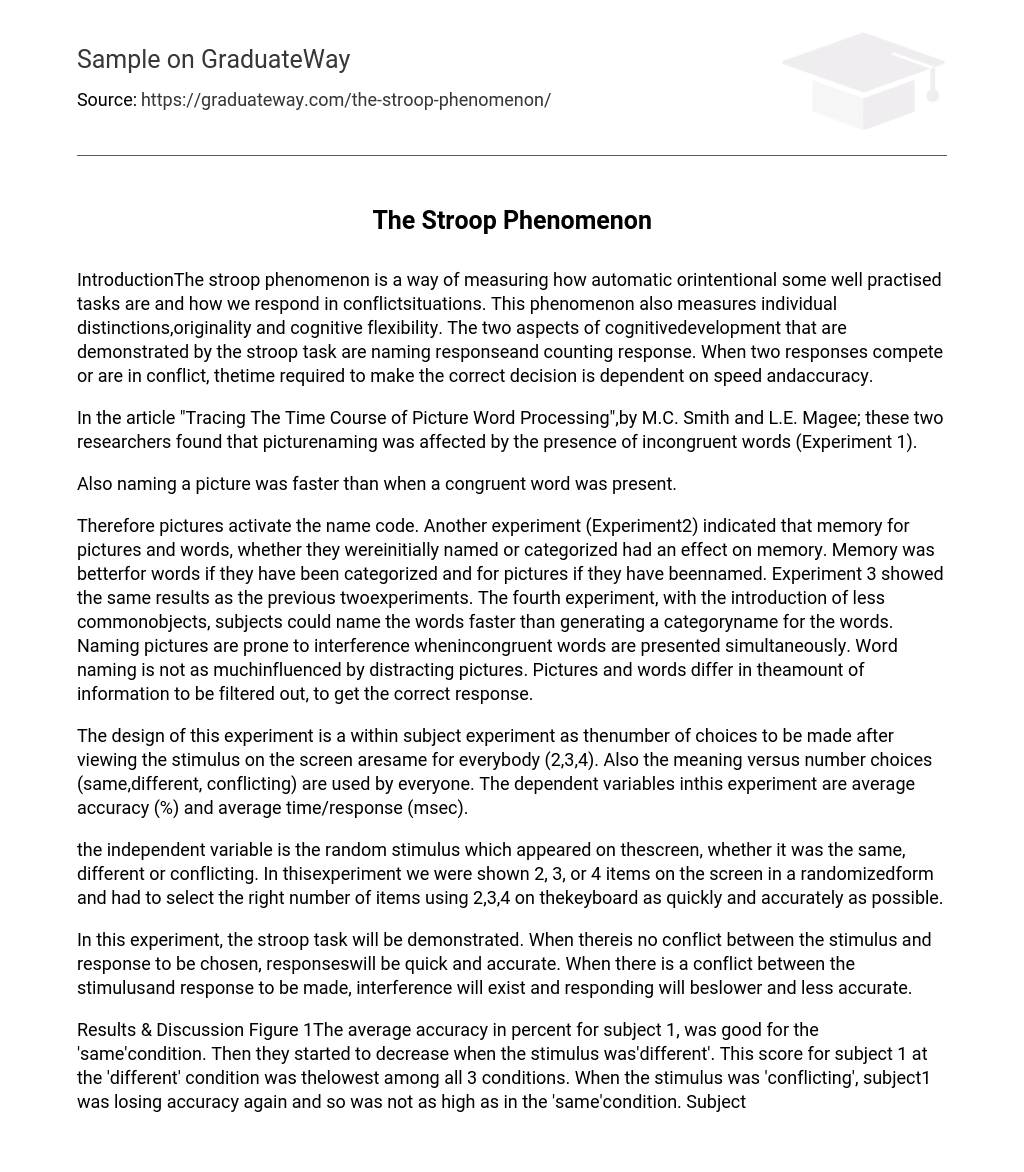The stroop phenomenon is a way of measuring how automatic orintentional some well practised tasks are and how we respond in conflictsituations. This phenomenon also measures individual distinctions,originality and cognitive flexibility. The two aspects of cognitivedevelopment that are demonstrated by the stroop task are naming responseand counting response. When two responses compete or are in conflict, thetime required to make the correct decision is dependent on speed andaccuracy.
In the article “Tracing The Time Course of Picture Word Processing”,by M.C. Smith and L.E. Magee; these two researchers found that picturenaming was affected by the presence of incongruent words (Experiment 1).
Also naming a picture was faster than when a congruent word was present. Therefore pictures activate the name code. Another experiment (Experiment2) indicated that memory for pictures and words, whether they wereinitially named or categorized had an effect on memory. Memory was betterfor words if they have been categorized and for pictures if they have beennamed. Experiment 3 showed the same results as the previous twoexperiments. The fourth experiment, with the introduction of less commonobjects, subjects could name the words faster than generating a categoryname for the words. Naming pictures are prone to interference whenincongruent words are presented simultaneously. Word naming is not as muchinfluenced by distracting pictures. Pictures and words differ in theamount of information to be filtered out, to get the correct response.
The design of this experiment is a within subject experiment as thenumber of choices to be made after viewing the stimulus on the screen aresame for everybody (2,3,4). Also the meaning versus number choices (same,different, conflicting) are used by everyone. The dependent variables inthis experiment are average accuracy (%) and average time/response (msec). the independent variable is the random stimulus which appeared on thescreen, whether it was the same, different or conflicting. In thisexperiment we were shown 2, 3, or 4 items on the screen in a randomizedform and had to select the right number of items using 2,3,4 on thekeyboard as quickly and accurately as possible.
In this experiment, the stroop task will be demonstrated. When thereis no conflict between the stimulus and response to be chosen, responseswill be quick and accurate. When there is a conflict between the stimulusand response to be made, interference will exist and responding will beslower and less accurate.
Results & Discussion Figure 1The average accuracy in percent for subject 1, was good for the ‘same’condition. Then they started to decrease when the stimulus was’different’. This score for subject 1 at the ‘different’ condition was thelowest among all 3 conditions. When the stimulus was ‘conflicting’, subject1 was losing accuracy again and so was not as high as in the ‘same’condition. Subject 1 was less accurate in the ‘different’ and’conflicting’ situations.
The average accuracy in percent for subject 2, was quite consistent,being one hundred percent in all conditions. So this subject had a higheraccuracy rate than subject. In relation to average time/response in milliseconds, subject 1 wasquicker than subject 2. Then condition where subject 1 slowed down themost was in the ‘different’ condition. In the ‘conflicting’ condition,subject 1 increased their speed more than in any other condition.
Subject 2 was quite consistent in all 3 conditions in relation toaverage time/response, with the milliseconds being only 3 or 4 differentfrom the other conditions. For subject 2 the highest responding rate wasin the ‘conflicting’ condition, followed by ‘same’, then the ‘different’condition.
This shows that in the ‘conflicting’ condition, the subjects responserate increased. In the ‘different’ condition the response decreased. Alsoif one subject has a higher accuracy rate than another subject, then theaverage time/response will be lower. The stroop task demonstrates that the naming response (same) is fasterthan the response used while counting (different) and that when 2 responsesconflict (conflicting), the time to make a correct decision increases.
Since people find the ‘conflict’ condition difficult, they will makemore errors and take more time to determine the correct response. So theaccuracy and response rate decreases in the ‘conflict’ situation. The difference in speed and accuracy in the 3 conditions (same,different, and conflicting) was the result of the experience with eachspecific condition. The more practice with each condition, the smaller thedifferences in speed and accuracy among the three conditions.
When there is no conflict, people are accurate and quick in respondingto the stimulus. So in the situations of ‘same’ and ‘different’ (22 and**), people will respond by pressing 3 and do well. Subject 1 was leastaccurate in the ‘different’ condition, but was still quicker compared tosubject 2; who was very accurate but not as quick as subject 1. In the ‘conflict’ situation, where an example of 222 showed up on thescreen and the response was to be 3. In this incident most people havetrouble responding due to interference, which leads to slower respondingand less accuracy. When subject 1 was presented with the ‘conflicting’situation, response was faster than in non- conflicting situations; butaccuracy suffered. Subject 2 was more accurate (100%) but was slower inresponding.
Just as in the research done by Smith and Magee, there was an effectby the presence of an incongruent (conflicting) stimuli. Also when there isa congruent (same) stimuli present, response becomes quick, as there is amuch faster processing rate which occurs. There is also support thatmemory is better for words, in our case numbers and for pictures that aregiven consistent symbols (eg. ***). When responding to the stimulus on thescreen, in ‘different’ conditions, if incongruent stimuli are presentedsimultaneously, there is a chance of disruption. Recognizing the correctnumber of items on the screen is not influenced much by distractingpictures (symbols). In our case this was a problem that Subject 1 washaving, so it is not fully supported.
Reference
- Magee, L.E. & Smith, M.C. Tracing The Time Course of Picture WordProcessing. Methods & Strategies : In Psychological Research, 1991,8, 361-388.





